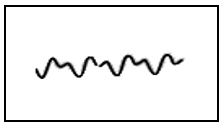
The figure shows the images of sound waves. Look at them and answer the following question.
Which sound is noise?
(A)

(B)

(C)

(D)





Answer
564.3k+ views
Hint: Noise implies any unwanted or disturbing energy from natural or man-made sources. Noise is usually considered unpleasant, loud, or disruptive to hearing. Sound waveforms are judged based on amplitude, pitch, loudness, and tone. These are the properties of any sound sample.
Complete step by step answer:
What we perceive as the pitch is the frequency of the sound. The shrill sound has a higher pitch, for example, the chirping of a bird, whereas the roar of a lion would have a smaller pitch. The frequencies of the given sound samples are in increasing order from A to D, which means that the shrillest sound is D.
Coming to loudness, it is a measure of the amplitude of the sound wave. It is an indication of the energy carried by the wave. The amplitude of the given waveforms increases from A to C but D has completely random amplitudes at different times.
The most striking thing about any sound is its periodicity. Music or tonal sounds are periodic whereas noise is randomized, dissipating energy into the medium.
Thus an analysis of the given waveforms shows that the waveform D is aperiodic, has random high and low amplitudes and has the highest frequency among all the given waveforms.
Therefore the image (D) depicts a noise.
Note: It should be noted both noise and music are vibrations through a medium, hence strictly for physics, there’s no difference between them. We distinguish noise from music or any other sound because of the way our brain receives and perceives a sound. Continuous high levels of noise should always be avoided.
Complete step by step answer:
What we perceive as the pitch is the frequency of the sound. The shrill sound has a higher pitch, for example, the chirping of a bird, whereas the roar of a lion would have a smaller pitch. The frequencies of the given sound samples are in increasing order from A to D, which means that the shrillest sound is D.
Coming to loudness, it is a measure of the amplitude of the sound wave. It is an indication of the energy carried by the wave. The amplitude of the given waveforms increases from A to C but D has completely random amplitudes at different times.
The most striking thing about any sound is its periodicity. Music or tonal sounds are periodic whereas noise is randomized, dissipating energy into the medium.
Thus an analysis of the given waveforms shows that the waveform D is aperiodic, has random high and low amplitudes and has the highest frequency among all the given waveforms.
Therefore the image (D) depicts a noise.
Note: It should be noted both noise and music are vibrations through a medium, hence strictly for physics, there’s no difference between them. We distinguish noise from music or any other sound because of the way our brain receives and perceives a sound. Continuous high levels of noise should always be avoided.
Recently Updated Pages
Master Class 11 Social Science: Engaging Questions & Answers for Success

Master Class 11 Physics: Engaging Questions & Answers for Success

Master Class 11 Maths: Engaging Questions & Answers for Success

Master Class 11 Economics: Engaging Questions & Answers for Success

Master Class 11 Computer Science: Engaging Questions & Answers for Success

Master Class 11 Chemistry: Engaging Questions & Answers for Success

Trending doubts
What is meant by exothermic and endothermic reactions class 11 chemistry CBSE

Which type of resource is iron ore A Renewable B Biotic class 11 social science CBSE

10 examples of friction in our daily life

Differentiate between an exothermic and an endothermic class 11 chemistry CBSE

Difference Between Prokaryotic Cells and Eukaryotic Cells

1 Quintal is equal to a 110 kg b 10 kg c 100kg d 1000 class 11 physics CBSE




